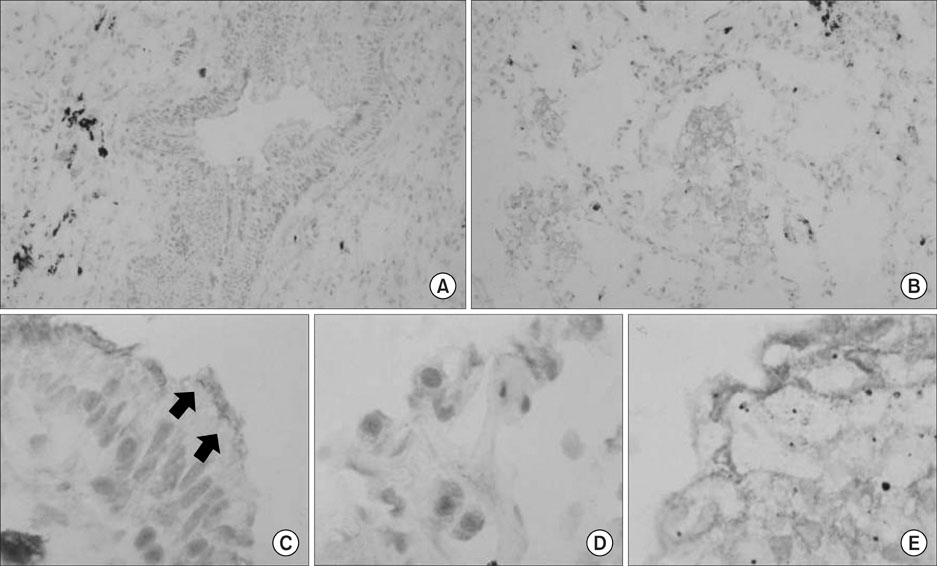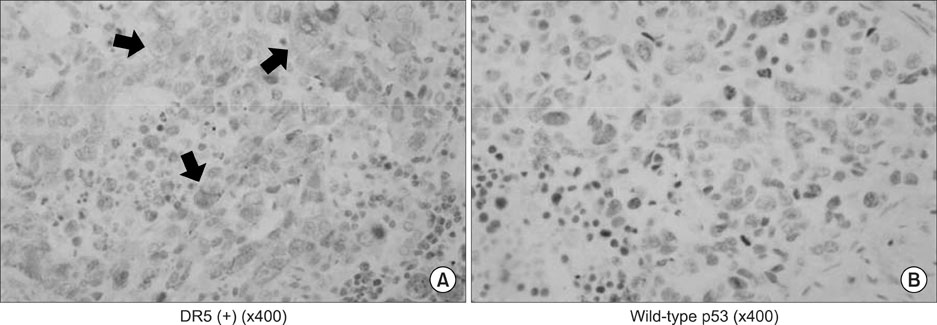Tuberc Respir Dis.
2008 Apr;64(4):278-284. 10.4046/trd.2008.64.4.278.
Immunohistochemical Analysis for the Expression of DR5 TRAIL Receptor and p53 in Non-small Cell Lung Cancer
- Affiliations
-
- 1Department of Internal Medicine, Konkuk University School of Medicine, Seoul, Korea. kyleemd@kuh.ac.kr
- KMID: 1970178
- DOI: http://doi.org/10.4046/trd.2008.64.4.278
Abstract
-
BACKGROUND: TRAIL is a promising anticancer agent which induces selective tumor cell death due to a unique receptor system that includes death receptors and decoy receptors. DR5 TRAIL receptor is an originally identified p53-regulated death receptor gene that was induced, by doxorubicine, only in cells with a wild-type p53 status. We investigated that focused on the correlation between the DR5 and p53 expressions in non-small cell lung cancer (NSCLC).
METHODS
Immunohistochemical analysis, with using avidin-biotinylated horseradish peroxidase complex, was carried out in 89 surgically resected NSCLC formalin-fixed paraffin-embedded tissue sections. As primary antibodies, we used anti-DR5 polyclonal antibody and anti-p53 monoclonal antibody. A negative control was processed with each slide. The positive tumor cells were quantified twice and these values were expressed as percentage of the total number of tumor cells, and the intensity of immunostaining was expressed. The analysis of the DR5 expression was done separately in tumor area and in a nearby region of normal tissue.
RESULTS
The DR5 expression was high in the bronchial epithelium (89% of cases) but this was almost absent in type I & II pneumocytes, lymphocytes and smooth muscle cells. High DR5 expression rate in tumor was seen in 28% (15/53) of squamous cell carcinomas, in 47% (15/32) of adenocarcinomas and, in 50% (2/4) of large cell carcinomas. The DR5 expression did not show any statistical significance relationship with the T stage, N stage, or survival. However, the DR5 expression showed significant inverse correlation with the p53 expression. (p<0.01).
CONCLUSION
We demonstrated that the DR5 expression in NSCLC via immunohistochemical analysis is relatively tumor-specific except for that in the normal bronchial epithelium and it is significantly dependent on the p53 status. This might be in vivo evidence for the significance of the DR5 gene as a p53 downstream gene.
MeSH Terms
Figure
Reference
-
1. Ashkenazi A, Dixit VM. Death receptors: signaling and modulation. Science. 1998. 281:1305–1308.2. Ashkenazi A, Pai RC, Fong S, Leung S, Lawrence DA, Marsters SA, et al. Safety and antitumor activity of recombinant soluble Apo2 ligand. J Clin Invest. 1999. 104:155–162.3. Lawrence D, Shahrokh Z, Marsters S, Achilles K, Shih D, Mounho B, et al. Differential hepatocyte toxicity of recombinant Apo2L/TRAIL versions. Nat Med. 2001. 7:383–385.4. Walczak H, Miller RE, Ariail K, Gliniak B, Griffith TS, Kubin M, et al. Tumoricidal activity of tumor necrosis factor-related apoptosis-inducing ligand in vivo. Nat Med. 1999. 5:157–163.5. Wu GS, Burns TF, McDonald ER 3rd, Jiang W, Meng R, Krantz ID, et al. KILLER/DR5 is a DNA damage-inducible p53-regulated death receptor gene. Nat Genet. 1997. 17:141–143.6. Kim K, Takimoto R, Dicker DT, Chen Y, Gazitt Y, El-Deiry WS. Enhanced TRAIL sensitivity by p53 overexpression in human cancer but not normal cell lines. Int J Oncol. 2001. 18:241–247.7. Jang SH, Seol JY, Kim CH, Yoo CG, Kim YW, Han SK, et al. Additive effect of TRAIL and p53 gene transfer on apoptosis of human lung cancer cell lines. Int J Mol Med. 2004. 13:181–186.8. Bremer E, van Dam G, Kroesen BJ, Leij L, Helfrich W. Targeted induction of apoptosis cancer therapy: current progress and prospects. Trends Mol Med. 2006. 12:382–393.9. Gajewski TF. On the TRAIL toward death receptor-based cancer therapeutics. J Clin Oncol. 2007. 25:1305–1307.10. Tolcher AW, Mita M, Meropol NJ, von Mehren M, Patnaik A, Padavic K, et al. Phase I pharmacokinetic and biologic correlative study of mapatumumab, a fully human monoclonal antibody with agonist activity to tumor necrosis factor-related apoptosis-inducing ligand receptor-1. J Clin Oncol. 2007. 25:1390–1395.11. Cretney E, Uldrich AP, Berzins SP, Strasser A, Godfrey DI, Smyth MJ. Normal thymocyte negative selection in TRAIL-deficient mice. J Exp Med. 2003. 198:491–496.12. Lee SH, Shin MS, Kim HS, Lee HK, Park WS, Kim SY, et al. Alterations of the DR5/TRAIL receptor 2 gene in non-small cell lung cancers. Cancer Res. 1999. 59:5683–5686.13. Wu WG, Soria JC, Wang L, Kemp BL, Mao L. TRAIL-R2 is not correlated with p53 status and is rarely mutated in non-small cell lung cancer. Anticancer Res. 2000. 20:4525–4529.14. Spierings DC, de Vries EG, Timens W, Groen HJ, Boezen HM, de Jong S. Expression of TRAIL and TRAIL death receptors in stage III non-small cell lung cancer tumors. Clin Cancer Res. 2003. 9:3397–3405.15. Mitsiades N, Poulaki V, Mitsiades C, Tsokos M. Ewing's sarcoma family tumors are sensitive to tumor necrosis factor-related apoptosis-inducing ligand and express death receptor 4 and death receptor 5. Cancer Res. 2001. 61:2704–2712.16. Zhang XD, Franco A, Myers K, Gray C, Nguyen T, Hersey P. Relation of TNF-related apoptosis-inducing ligand (TRAIL) receptor and FLICE-inhibitory protein expression to TRAIL-induced apoptosis of melanoma. Cancer Res. 1999. 59:2747–2753.17. Zhang XD, Franco AV, Nguyen T, Gray CP, Hersey P. Differential localization and regulation of death and decoy receptors for TNF-related apoptosis-inducing ligand (TRAIL) in human melanoma cells. J Immunol. 2000. 164:3961–3970.18. El-Deiry WS. Insights into cancer therapeutic design based on p53 and TRAIL receptor signaling. Cell Death Differ. 2001. 8:1066–1075.19. Oren M. Decision making by p53: life, death, and cancer. Cell Death Differ. 2003. 10:431–442.20. Sheikh MS, Fornace AJ Jr. Death and decoy receptors and p53-mediated apoptosis. Leukemia. 2000. 14:1509–1513.21. Liu X, Yue P, Khuri FR, Sun SY. Decoy receptor 2 (DcR2) is a p53 target gene and regulates chemosensitivity. Cancer Res. 2005. 65:9169–9175.
- Full Text Links
- Actions
-
Cited
- CITED
-
- Close
- Share
- Similar articles
-
- Immunohistochemical Study of the Expression of the p53 Protein in Primary Lung Cancer
- Expression of p53 and nm23 Proteins in Non-Small Cell Lung Cancer
- Cytotoxic Effects of Tumor Necrosis Factor-related Apoptosis-inducing Ligand (TRAIL)and its Molecular Mechanism in Human Gastric Cancer Cells
- The Significance of p53 Expression in Serum and Tissue from Patients with Lung Cancer
- The Immunohistochemical analysis for the expression of survivin, an inhibitor of apoptosis protein, in non-small cell lung cancer



